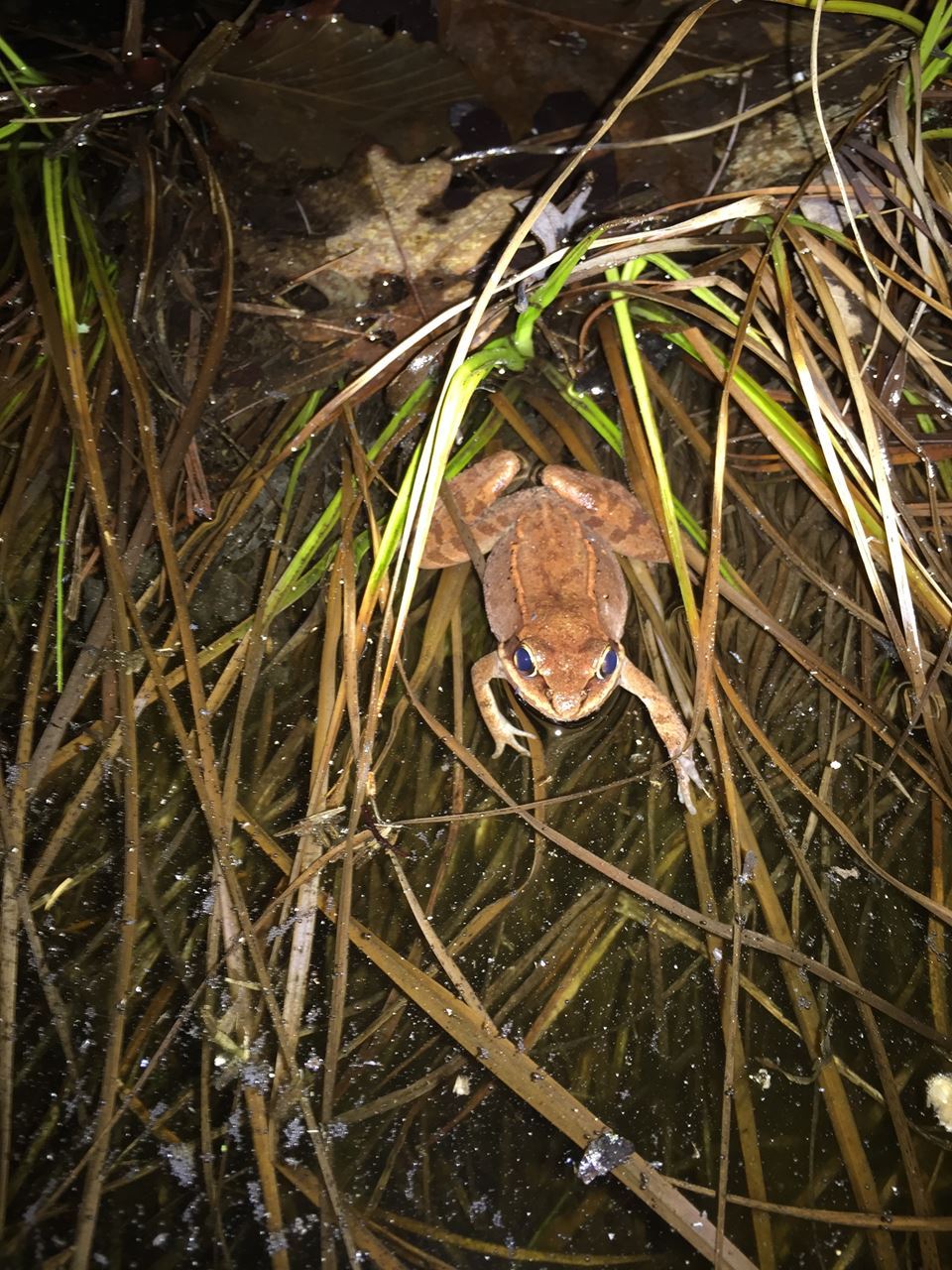 Biologist Nathan Mineo
Biologist Nathan Mineo
Did You Know...?
Wood frogs are Affected by Climate Change
Written by Nathan Mineo
Reprinted from the 2021 Cape Ann Vernal Pond Team Newsletter
Photograph by Cheryl Briscoe
Did you know that wood frogs are affected by climate change? I know this fact may seem obvious, but exactly how wood frogs are affected is far less obvious.
Climate change has a variety of impacts, including changing precipitation patterns. This means that winters may have less snow (and more sporadic snow events), leaving less snowpack and earlier thawing. Snowpack, as it turns out, is very beneficial in a lot of different ways. One way is that it insulates the ground in the winter. Around here, winter temperatures may fluctuate a lot (like 0 degrees one day and 50 degrees the next), but if there is snow insulating the soil, the ground temperature will remain fairly constant. Since wood frogs overwinter by allowing themselves to freeze solid under leaf litter, snowpack is an important aspect of their survival. It’s ability to moderate temperatures means that the frogs won’t go through multiple freeze-thaw cycles in a winter. This is important because every time a wood frog thaws, its body temperature increases, and it starts to use more energy. The more energy it uses in the winter, the less it has in the spring when it emerges to breed. Remember, wood frogs are one of the first amphibians to emerge, well before their food sources, so their energy reserves have to be substantial for them to survive through their breeding season and then hang on long enough for their food to emerge so they can eat and reenergize. Less snowpack in the winter and earlier thawing can strain the limits of the wood frog’s energy reserves, which has a negative effect on survival.
Straining energy reserves likely has a bigger impact on females whose energy demands are greater than males due to the fact that they carry energy-demanding eggs. In fact, Michael Bernard from the University of Michigan, found females that breed after a warmer winter lay 4.3% fewer eggs. The reason for this is thought to be the higher energy usage that occurs during a warmer winter. More energy use in the winter means less energy can be put into producing eggs, thus fewer eggs per clutch.
 Many studies about how climate change affects wood frogs focuses on this thing called phenological shifts. Basically, this just refers to how the seasonal timing of an organism (wood frogs in our case) changes due to a changing climate. For instance, wood frogs emerge at the end of winter when the ponds are thawed, and temperatures are above freezing (the exact cues that tell wood frogs that it’s time to wake up and get moving are still unknown). When climate change causes temperatures to rise and ice to thaw earlier in the winter, this causes wood frogs to wake up sooner. There are both pros and cons to this, but based on what I’ve read so far, the pros and cons kind of balance out. Warmer winters means earlier breeding, but that doesn’t necessarily mean earlier metamorphosis because the tadpoles of earlier breeding events tend to experience cooler early spring temperatures, which slows metamorphosis. However, even with the delay in development, wood frogs from eggs laid earlier metamorphosized and emerged sooner, which could be viewed as beneficial to the frogs.
Many studies about how climate change affects wood frogs focuses on this thing called phenological shifts. Basically, this just refers to how the seasonal timing of an organism (wood frogs in our case) changes due to a changing climate. For instance, wood frogs emerge at the end of winter when the ponds are thawed, and temperatures are above freezing (the exact cues that tell wood frogs that it’s time to wake up and get moving are still unknown). When climate change causes temperatures to rise and ice to thaw earlier in the winter, this causes wood frogs to wake up sooner. There are both pros and cons to this, but based on what I’ve read so far, the pros and cons kind of balance out. Warmer winters means earlier breeding, but that doesn’t necessarily mean earlier metamorphosis because the tadpoles of earlier breeding events tend to experience cooler early spring temperatures, which slows metamorphosis. However, even with the delay in development, wood frogs from eggs laid earlier metamorphosized and emerged sooner, which could be viewed as beneficial to the frogs.
Pretty Wood frog on CAVPT Nighttime Vernal Pond Field Trip
photograph by Victoria Rolf
Ultimately, the ways in which wood frogs will be impacted by climate change depends a lot on where they are. The disruptions in rainfall and snowpack will be different in different parts of the wood frog’s range and have very localized effects. Wood frogs will likely disappear from parts of its range, especially on its Southern edge due to hotter, dryer summers and shorter, warmer winters. Cape Ann experiences a strong ocean effect, which moderates temperatures in both the winter and summer months. I wonder how that ocean effect currently influences amphibian breeding, and how it will change with a changing climate. Will amphibians on Cape Ann be insulated from the negative effects of climate change due to the ocean effect, or will the strain of climate change be amplified because of it?
Citations:
Benard MF. Warmer winters reduce frog fecundity and shift breeding phenology, which consequently alters larval development and metamorphic timing. Glob Chang Biol. 2015 Mar;21(3):1058-65. doi: 10.1111/gcb.12720. Epub 2014 Sep 29. PMID: 25263760.
Fitzpatrick, MJ, Porter, WP, Pauli, JN, Kearney, MR, Notaro, M, Zuckerberg, B. Future winters present a complex energetic landscape of decreased costs and reduced risk for a freeze‐tolerant amphibian, the Wood Frog (Lithobates sylvaticus). Glob Change Biol. 2020; 26: 6350– 6362. https://doi.org/10.1111/gcb.15321.